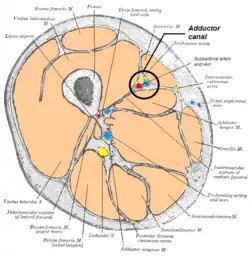Adductor canal
The adductor canal, also known as the subsartorial canal or Hunter’s canal, is an aponeurotic tunnel in the middle third of the thigh. It extends from the apex of the femoral triangle to the adductor hiatus.
| Adductor canal | |
|---|---|
 The femoral artery. (Canal not labeled, but region visible at center right.) | |
 Cross-section through the middle of the thigh (the right thigh if seen from below) | |
| Details | |
| Identifiers | |
| Latin | Canalis adductorius |
| TA98 | A04.7.03.006 |
| TA2 | 2611 |
| FMA | 58781 |
| Anatomical terminology | |
Structure
The adductor canal extends from the apex of the femoral triangle to the adductor hiatus. It is an intermuscular cleft situated on the medial aspect of the middle third of the anterior compartment of the thigh, and has the following boundaries:
- medial wall - sartorius.
- Posterior wall - adductor longus and adductor magnus.
- Anterior- vastus medialis.
It is covered by a strong aponeurosis which extends from the vastus medialis, across the femoral vessels to the adductor longus and magnus.
- Lying on the aponeurosis is the sartorius (tailor's) muscle.
Contents
The canal contains the subsartorial artery (distal segment of the femoral artery), subsartorial vein (distal segment of the femoral vein), and branches of the femoral nerve (specifically, the saphenous nerve, and the nerve to the vastus medialis).[1][2] The femoral artery with its vein and the saphenous nerve enter this canal through the superior foramen. Then, the saphenous nerve and artery and vein of genus descendens exit through the anterior foramen, piercing the vastoadductor intermuscular septum. Finally, the femoral artery and vein exit via the inferior foramen (usually called the hiatus) through the inferior space between the oblique and medial heads of adductor magnus.[3]
Clinical significance
The saphenous nerve may be compressed in the adductor canal.[4] The adductor canal may be accessed for a saphenous nerve block, often used to treat pain caused by this compression.[4]
Additional Images
 Adductor canal
Adductor canal Adductor canal
Adductor canal
References
![]() This article incorporates text in the public domain from page 627 of the 20th edition of Gray's Anatomy (1918)
This article incorporates text in the public domain from page 627 of the 20th edition of Gray's Anatomy (1918)
- Sauerland, Eberhardt K.; Patrick W. Tank; Tank, Patrick W. (2005). Grant's dissector. Hagerstown, MD: Lippincott Williams & Wilkins. p. 128. ISBN 0-7817-5484-4.
- Sambrook, Philip (2010-01-01), Sambrook, Philip; Schrieber, Leslie; Taylor, Thomas; Ellis, Andrew M. (eds.), "Bone Structure and Function in Normal and Disease States", The Musculoskeletal System (Second Edition), Churchill Livingstone, pp. 61–76, doi:10.1016/b978-0-7020-3377-3.00005-6, ISBN 978-0-7020-3377-3, retrieved 2021-02-18
- А.В. Николаев. (2007). Топографическая анатомия и оперативная хирургия. Москва: ГЭОТАР-Медиа (GEOTAR-Media). pp. 174–176. ISBN 978-5-9704-1207-7.
- Zhang, Yi (2011-01-01), Lennard, Ted A.; Walkowski, Stevan; Singla, Aneesh K.; Vivian, David G. (eds.), "27 - Lower Extremity: Saphenous Nerve Block", Pain Procedures in Clinical Practice (Third Edition), Saint Louis: Hanley & Belfus, pp. 267–270, doi:10.1016/b978-1-4160-3779-8.10027-2, ISBN 978-1-4160-3779-8, retrieved 2021-02-18
- synd/105 at Who Named It?
- "CHAPTER 15: THE THIGH AND KNEE". Archived from the original on 21 January 2008. Retrieved 2008-01-27.
External links
- Anatomy photo:12:07-0103 at the SUNY Downstate Medical Center - "Anterior and Medial Thigh Region: Sartorius Muscle and the Adductor Canal"
- Anatomy photo:12:08-0105 at the SUNY Downstate Medical Center - "Anterior and Medial Thigh Region: Structures of the Adductor Canal"